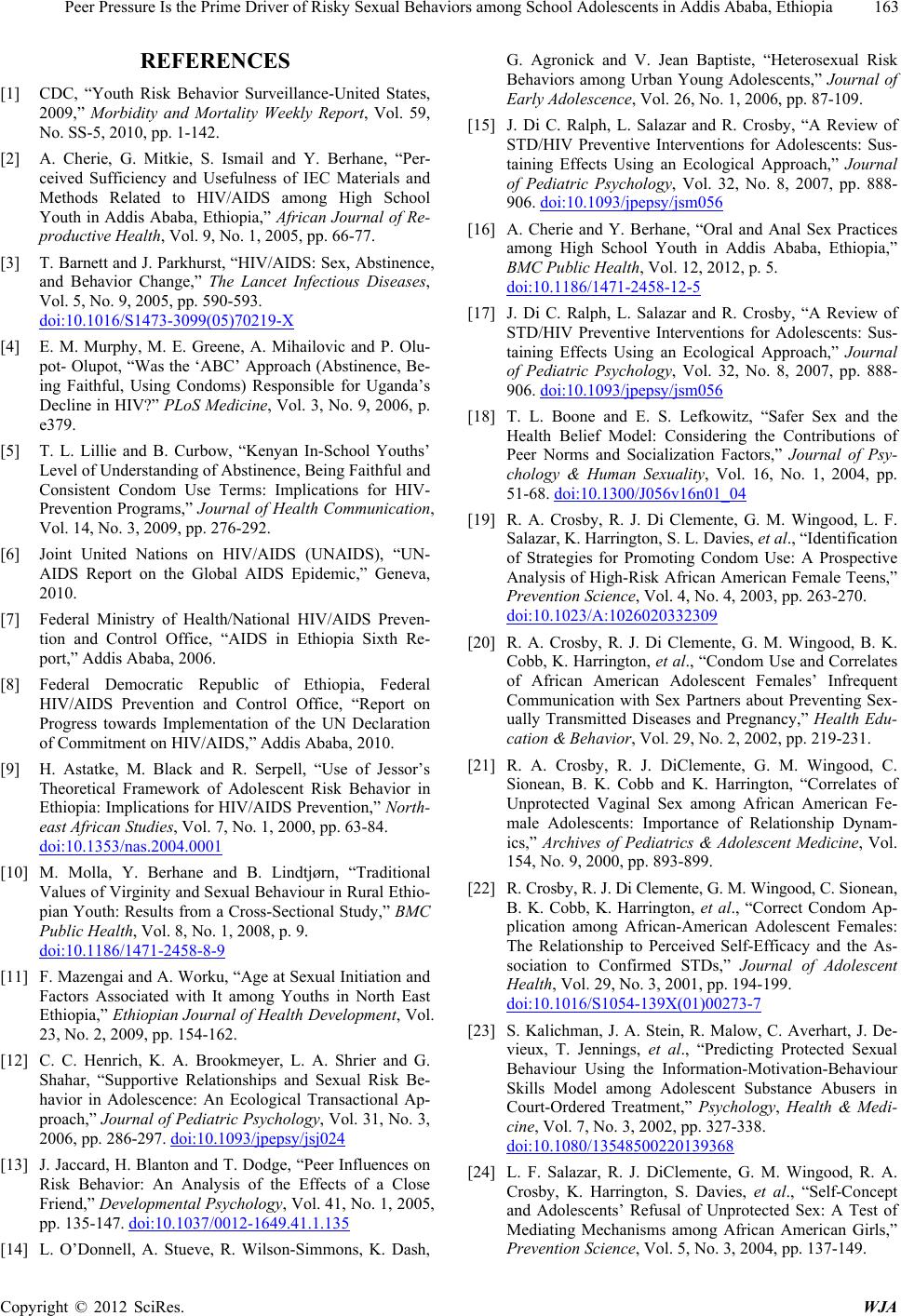
Peer Pressure Is the Prime Driver of Risky Sexual Behaviors among School Adolescents in Addis Ababa, Ethiopia 163
REFERENCES
[1] CDC, “Youth Risk Behavior Surveillance-United States,
2009,” Morbidity and Mortality Weekly Report, Vol. 59,
No. SS-5, 2010, pp. 1-142.
[2] A. Cherie, G. Mitkie, S. Ismail and Y. Berhane, “Per-
ceived Sufficiency and Usefulness of IEC Materials and
Methods Related to HIV/AIDS among High School
Youth in Addis Ababa, Ethiopia,” African Journal of Re-
productive Health, Vol. 9, No. 1, 2005, pp. 66-77.
[3] T. Barnett and J. Parkhurst, “HIV/AIDS: Sex, Abstinence,
and Behavior Change,” The Lancet Infectious Diseases,
Vol. 5, No. 9, 2005, pp. 590-593.
doi:10.1016/S1473-3099(05)70219-X
[4] E. M. Murphy, M. E. Greene, A. Mihailovic and P. Olu-
pot- Olupot, “Was the ‘ABC’ Approach (Abstinence, Be-
ing Faithful, Using Condoms) Responsible for Uganda’s
Decline in HIV?” PLoS Medi cine, Vol. 3, No. 9, 2006, p.
e379.
[5] T. L. Lillie and B. Curbow, “Kenyan In-School Youths’
Level of Understanding of Abstinence, Being Faithful and
Consistent Condom Use Terms: Implications for HIV-
Prevention Programs,” Journal of Health Communication,
Vol. 14, No. 3, 2009, pp. 276-292.
[6] Joint United Nations on HIV/AIDS (UNAIDS), “UN-
AIDS Report on the Global AIDS Epidemic,” Geneva,
2010.
[7] Federal Ministry of Health/National HIV/AIDS Preven-
tion and Control Office, “AIDS in Ethiopia Sixth Re-
port,” Addis Ababa, 2006.
[8] Federal Democratic Republic of Ethiopia, Federal
HIV/AIDS Prevention and Control Office, “Report on
Progress towards Implementation of the UN Declaration
of Commitment on HIV/AIDS,” Addis Ababa, 2010.
[9] H. Astatke, M. Black and R. Serpell, “Use of Jessor’s
Theoretical Framework of Adolescent Risk Behavior in
Ethiopia: Implications for HIV/AIDS Prevention,” North-
east African Studies, Vol. 7, No. 1, 2000, pp. 63-84.
doi:10.1353/nas.2004.0001
[10] M. Molla, Y. Berhane and B. Lindtjørn, “Traditional
Values of Virginity and Sexual Behaviour in Rural Ethio-
pian Youth: Results from a Cross-Sectional Study,” BMC
Public Health, Vol. 8, No. 1, 2008, p. 9.
doi:10.1186/1471-2458-8-9
[11] F. Mazengai and A. Worku, “Age at Sexual Initiation and
Factors Associated with It among Youths in North East
Ethiopia,” Ethiopian Journal of Health Development, Vol.
23, No. 2, 2009, pp. 154-162.
[12] C. C. Henrich, K. A. Brookmeyer, L. A. Shrier and G.
Shahar, “Supportive Relationships and Sexual Risk Be-
havior in Adolescence: An Ecological Transactional Ap-
proach,” Journal of Pediatric Psychology, Vol. 31, No. 3,
2006, pp. 286-297. doi:10.1093/jpepsy/jsj024
[13] J. Jaccard, H. Blanton and T. Dodge, “Peer Influences on
Risk Behavior: An Analysis of the Effects of a Close
Friend,” Developmental Psychology, Vol. 41, No. 1, 2005,
pp. 135-147. doi:10.1037/0012-1649.41.1.135
[14] L. O’Donnell, A. Stueve, R. Wilson-Simmons, K. Dash,
G. Agronick and V. Jean Baptiste, “Heterosexual Risk
Behaviors among Urban Young Adolescents,” Journal of
Early Adolescence, Vol. 26, No. 1, 2006, pp. 87-109.
[15] J. Di C. Ralph, L. Salazar and R. Crosby, “A Review of
STD/HIV Preventive Interventions for Adolescents: Sus-
taining Effects Using an Ecological Approach,” Journal
of Pediatric Psychology, Vol. 32, No. 8, 2007, pp. 888-
906. doi:10.1093/jpepsy/jsm056
[16] A. Cherie and Y. Berhane, “Oral and Anal Sex Practices
among High School Youth in Addis Ababa, Ethiopia,”
BMC Public Health, Vol. 12, 2012, p. 5.
doi:10.1186/1471-2458-12-5
[17] J. Di C. Ralph, L. Salazar and R. Crosby, “A Review of
STD/HIV Preventive Interventions for Adolescents: Sus-
taining Effects Using an Ecological Approach,” Journal
of Pediatric Psychology, Vol. 32, No. 8, 2007, pp. 888-
906. doi:10.1093/jpepsy/jsm056
[18] T. L. Boone and E. S. Lefkowitz, “Safer Sex and the
Health Belief Model: Considering the Contributions of
Peer Norms and Socialization Factors,” Journal of Psy-
chology & Human Sexuality, Vol. 16, No. 1, 2004, pp.
51-68. doi:10.1300/J056v16n01_04
[19] R. A. Crosby, R. J. Di Clemente, G. M. Wingood, L. F.
Salazar, K. Harrington, S. L. Davies, et al., “Identification
of Strategies for Promoting Condom Use: A Prospective
Analysis of High-Risk African American Female Teens,”
Prevention Science, Vol. 4, No. 4, 2003, pp. 263-270.
doi:10.1023/A:1026020332309
[20] R. A. Crosby, R. J. Di Clemente, G. M. Wingood, B. K.
Cobb, K. Harrington, et al., “Condom Use and Correlates
of African American Adolescent Females’ Infrequent
Communication with Sex Partners about Preventing Sex-
ually Transmitted Diseases and Pregnancy,” Health Edu-
cation & Behavior, Vol. 29, No. 2, 2002, pp. 219-231.
[21] R. A. Crosby, R. J. DiClemente, G. M. Wingood, C.
Sionean, B. K. Cobb and K. Harrington, “Correlates of
Unprotected Vaginal Sex among African American Fe-
male Adolescents: Importance of Relationship Dynam-
ics,” Archives of Pediatrics & Adolescent Medicine, Vol.
154, No. 9, 2000, pp. 893-899.
[22] R. Crosby, R. J. Di Clemente, G. M. Wingo od, C. S i o nean,
B. K. Cobb, K. Harrington, et al., “Correct Condom Ap-
plication among African-American Adolescent Females:
The Relationship to Perceived Self-Efficacy and the As-
sociation to Confirmed STDs,” Journal of Adolescent
Health, Vol. 29, No. 3, 2001, pp. 194-199.
doi:10.1016/S1054-139X(01)00273-7
[23] S. Kalichman, J. A. Stein, R. Malow, C. Averhart, J. De-
vieux, T. Jennings, et al., “Predicting Protected Sexual
Behaviour Using the Information-Motivation-Behaviour
Skills Model among Adolescent Substance Abusers in
Court-Ordered Treatment,” Psychology, Health & Medi-
cine, Vol. 7, No. 3, 2002, pp. 327-338.
doi:10.1080/13548500220139368
[24] L. F. Salazar, R. J. DiClemente, G. M. Wingood, R. A.
Crosby, K. Harrington, S. Davies, et al., “Self-Concept
and Adolescents’ Refusal of Unprotected Sex: A Test of
Mediating Mechanisms among African American Girls,”
Prevention Science, Vol. 5, No. 3, 2004, pp. 137-149.
Copyright © 2012 SciRes. WJA